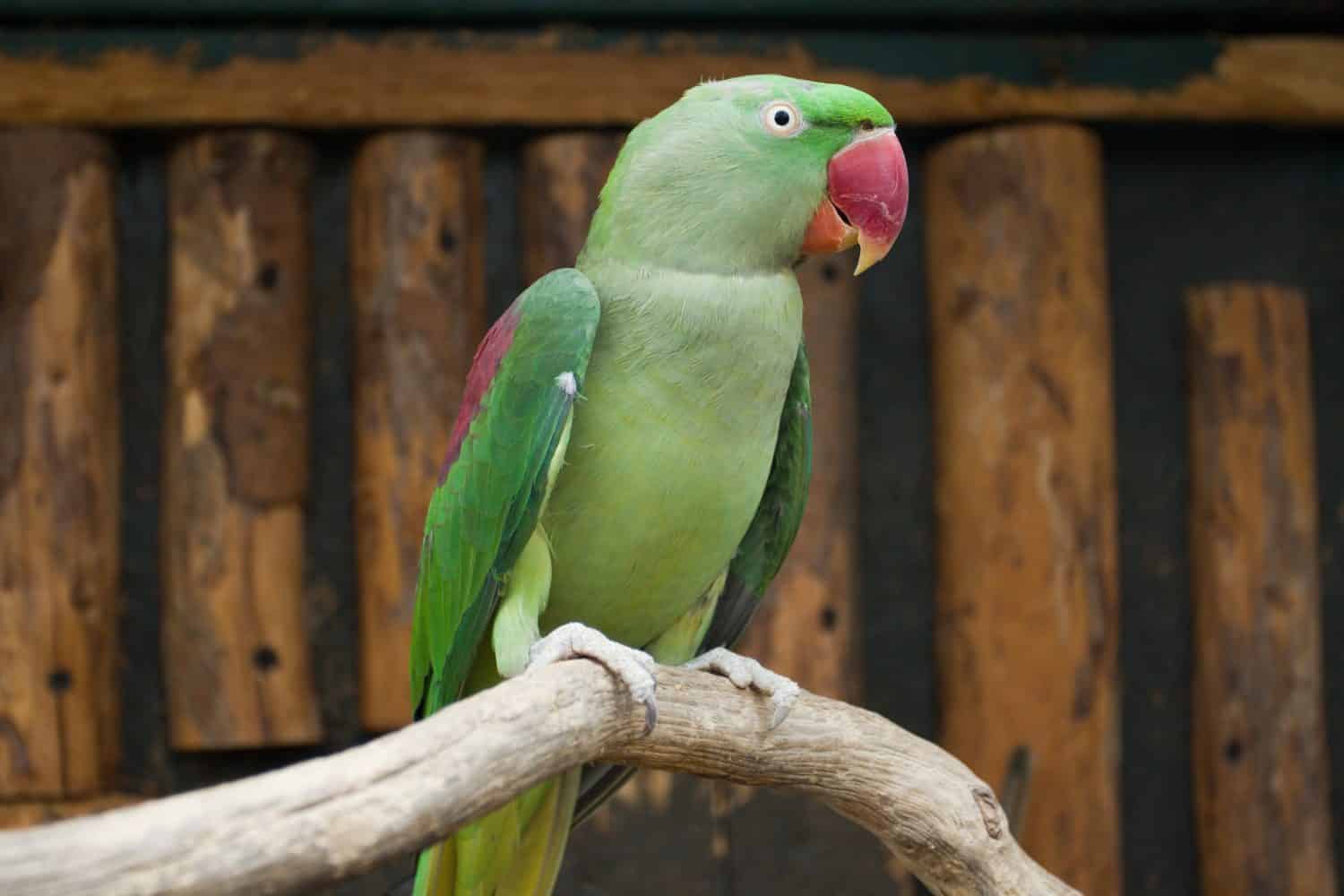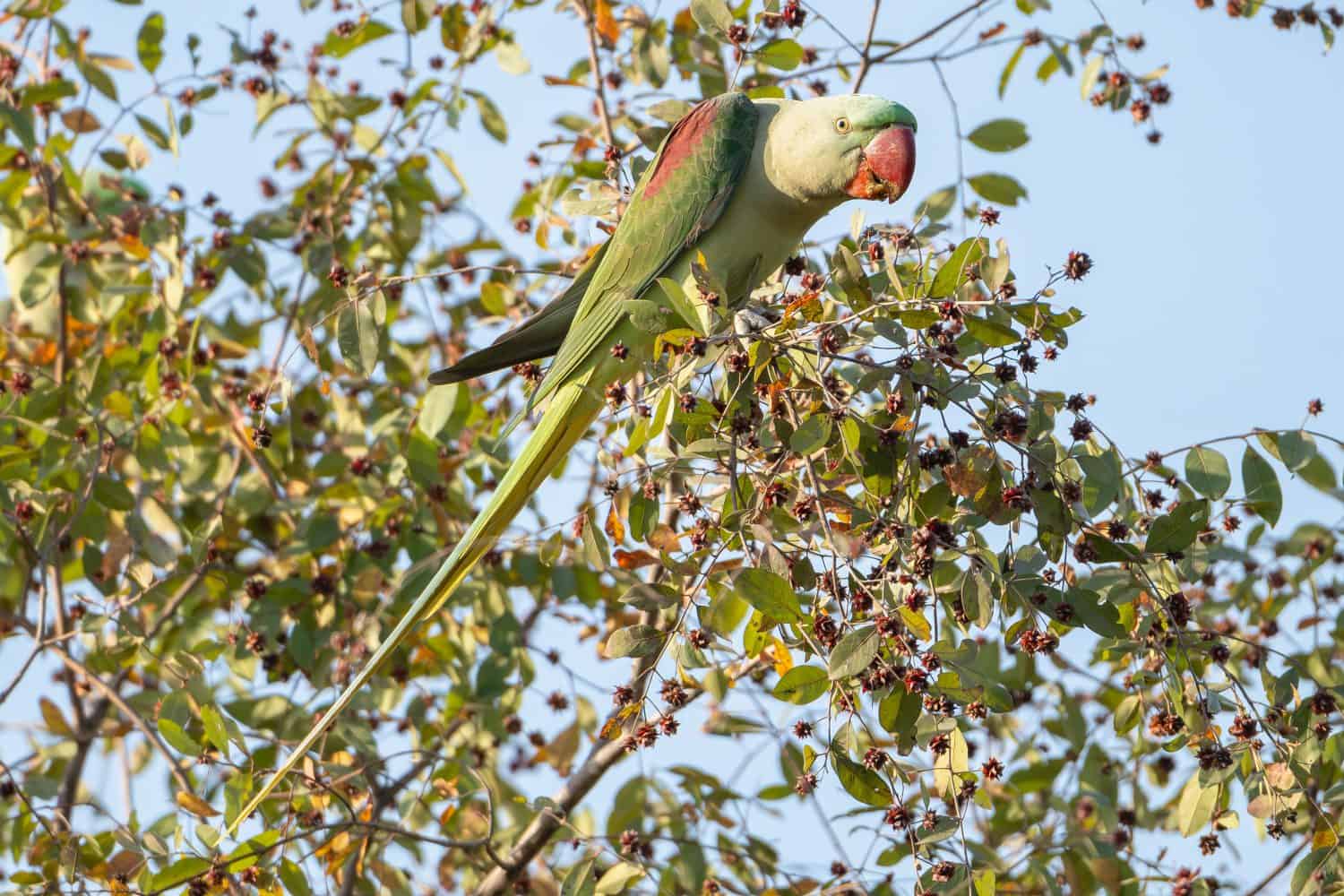The Alexandrine parakeet is a medium-sized parrot from the Psittaculidae family, which contains Old World parrots. These popular pet birds are named after Alexander the Great, who transported numerous birds from their native homes to European and Mediterranean countries. Royal and noble people kept these parrots as pets, and today, the Alexandrine parakeet is still popular in aviculture. Its bright plumage and intelligence are desirable for bird enthusiasts, as well as its ability to bond closely with one person.
If you are interested in learning more about the Alexandrine parakeet, dive into this article and discover their unique characteristics, personalities, diets, and prevalence in the pet industry.
Appearance

Royal and noble people kept these parrots as pets. The Alexandrine parakeet is still popular in aviculture.
©Dan_Koleska/Shutterstock.com
Alexandrine parakeets are some of the largest parakeets in the world, measuring up to 24 inches long and weighing between seven and 10 ounces. Their tail alone measures 11 to 14 inches long.
This species is mainly dark to light green with bluish-gray coloring on its cheeks and back of its neck. Its abdomen is yellowish-green, and it features red shoulder patches and a large red and yellow beak. Its long, elegant tail is green and blue above and yellow below with a yellow tip.
This species is dimorphic, meaning males and females have different appearances. Adult males have pink bands on their napes and a black stripe across the lower part of their cheeks. Adult females lack both of these characteristics, and the young appear like the females, except with shorter tails.
There are five recognized subspecies of the Alexandrine parakeet. Each one has a unique distribution, along with slight differences in appearance.
Personality and Behavior
In the wild, these parakeets live in small flocks for most of the year. Occasionally, they join larger flocks to find food near communal roosts. Not much is known about their behavior and personality in the wild.
Alexander parakeets that live in captivity are known for their tame and affectionate personalities. These birds tend to form strong bonds with one special person and shun others in the house. Asiatic parakeets are not for beginner bird owners. This species needs proper care and socialization, especially during the hormonal years.
These birds are also known for their intelligence and talking abilities. They can be quite loud, as their vocalizations are meant to travel long distances to communicate with those in the wild.
Diet, Nutrition, and Health
In its natural habitat, the Alexandrine parakeet eats wild and cultivated seeds, nuts, buds, and fruits. The small flocks it forms near food sources can be damaging to grain crops and ripening fruit.
As pets, these parakeets live on commercial pellets, fresh fruits, grains, seeds, tree nuts, and some vegetables. It’s essential to mimic this bird’s diet closely to its wild habits.
Habitat and Breeding

These birds need lots of play and exercise to keep them physically and mentally health
©Piotr Poznan/Shutterstock.com
Alexandrine parakeets live in forests and woodlands, but you can also spot them in mangrove forests and agricultural fields. These birds are native to South Asia and Southeast Asia, including India, Sri Lanka, Nepal, Bhutan, Bangladesh, Myanmar, Vietnam, Cambodia, Laos, Thailand, and several more countries.
They have also established feral populations alongside rose-ringed parakeets in Iraq, Saudi Arabia, Kuwait, Qatar, Bahrain, and Iran.
In their native habitats, these parakeets breed from November to April and use tree hollows and excavated holes as nesting sites. Females lay two to four eggs and incubate them for approximately 24 days. The chicks stay with their parents until three or months old.
Aviculture
Due to its playful nature, long lifespans, and affectionate personality, the Alexandrine parakeet is one of the most sought-after birds in the Indian market. They are often imported to many countries outside their native range.
These birds can live up to 30 years in captivity with proper care. The Alexandrine parakeet needs lots of play and exercise to keep physically and mentally healthy. They need large cages, at least 15-foot enclosures, and should have at least several hours a day out of their cage to explore and play.
Conservation
Due to excessive capture in the illegal wildlife trade and habitat loss, the Alexandrine parakeet is listed as near threatened by the IUCN. Its population has declined the most in parts of Pakistan, Laos, Cambodia, and Thailand.
FAQs
How Much is an Alexandrine Parakeet in the US?
Alexandrine parakeets range between $600 and $800, depending on their age and certain characteristics.
What Size Cage Do You Need for an Alexandrine Parakeet?
Ideally, the bigger the better. Large walk-in cages are best for this type of bird due to its long tail feathers and larger body. Proper cages for this species run anywhere from $200 to $1,000.
Can Alexandrine Parakeets Talk?
The Alexandrine parakeet can mimic human speech, including other vocalizations, like ringing noises. Their vocals are deep, and they make “klak-klak-klak-klak” and “gr-aak” calls. When alarmed, their calls are harsh and urgent. It also makes shrieking sounds in the wild when chasing away predators.
The photo featured at the top of this post is © Dan_Koleska/Shutterstock.com
Thank you for reading! Have some feedback for us? Contact the AZ Animals editorial team.







